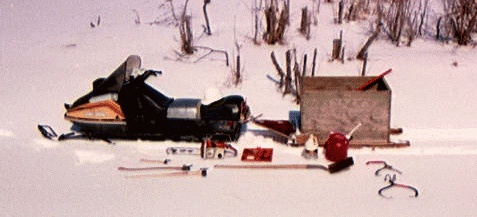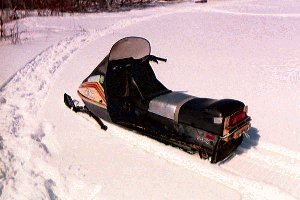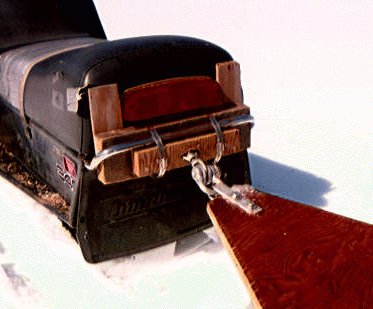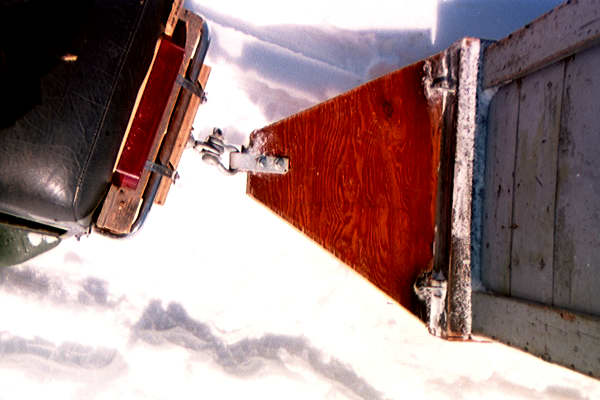

CHAIN SAW: If you're buying a used chain saw, stick with brands that are used by serious cutters in your area. We use a Sthil 030, a good dependable saw. There are now 2 types of saws on the new saw market. Weekend saws (made for infrequent use or as a 1st saw to learn on and later upgrade to a better saw), and saws made to last used by people who cut their firewood supply each year and by professional loggers. Sthil is a serious saw. The $100 saw sold in hardware stores is probably a weekend saw that could be used to see how serious you are about cutting wood. If you choose a weekend saw it must have an automatic chain oiler or forget it.
SAW CHAIN: Make sure you have a saw that has a chain brake that stops the chain if the saw jumps towards you while in use. We use safety chain and highly recommend it. Keep your chain sharp. It cuts better, lasts longer, and does a better job. We believe a dull chain can cause accidents. Keep the chain sharp by buying a manual chain sharpener that allows you to keep the file at the proper angle while you sharpen the saw. If you sharpen your saw at least once a day then it takes only one sweep of the file on each cutter to keep it sharp. We have people tell us a chain kept sharp, with no hits on rock can cut up to 200 cords of wood. Manufacturers suggest you buy 2 chain and a new bar and sprocket at the same time and alternate chains every once in a while so they can wear with the sprocket. Turn the bar over often to even wear on each side.
HARDHAT AND SAFETY EQUIPMENT: (The white hard hat is on the snowmobile seat, it is hard to see in the photo). You MUST have safety equipment. If you do not have good ear protection then you will go deaf (we know old timers who did not believe in ear protection and you can talk to them about this but they will not hear you). Wear ear protection when using the chain saw and when using the snowmobile. Safety glasses are essential for eye protection. Don't risk your vision. There are now safety helmets that provide hard hat, face guard, and hearing protection all in one unit. Good boots give more room for error around your feet, chaffs and leg guard give added protection, but not everyone decides to use them.
HATCHET, AX, MAUL: A hatchet is used to mark trees to cut and to trim branches missed by the chain saw. An ax or maul is used to split wood. We find a 6 lb maul easy to handle on most wood. Some people like a heavier maul.
GAS CAN (mixed gas and oil for the saw and snowmobile) and BAR OIL: Mix gas according to directions. Bar oil is better than motor oil for your chain because it is designed to stay on the bar. Regular motor comes off the chain too easy and can cause your chain to wear out early.
LOG PULLER: (see logpuller photo) Some people have used old ice clamps (see above) as a substitute. But the LOG PULLER is well worth the price. It puts a handle on a log and allows easy pulling to the cutting area. HIGHLY recommended.
TOOL BOX (for chain saw and snowmobile) Carry the basic tools you'll need for onsite adjustments and repairs.
SHOVEL: A flat bottomed shovel is handy for smoothing out bumps in the snow trail or for throwing snow on bare spots in the trail. If trails develop a washboard surface (like roads) then cut down the high bumps to fill in the low areas. This will put less strain on the hitch between the snow sled and the snowmobile. Washboard trails cause the sled to pull and push on the hitch as you move down the trail. Often a little work with a flat bottomed shovel will is just what the trail needs. The sooner you do the work the less work you do. Washboarding once started rapidly gets worse. An ounce of prevention is worth more than a pound of cure in this case.

If you already have a snowmobile then all you need is trailer hitch for the snow sled. If you are thinking of getting a snowmobile mainly for moving wood then it is recommended that you ask a friend or neighbor to pull your sled on a few test runs to make sure this system is right for you BEFORE you buy a snowmobile.
If you are planning on buying a used snowmobile, find out what price range you can afford and then check the local "Free Trader" or "Penny Saver" ad paper to see what years of used snowmobile are available for what you can afford. We figure, around here, about $500 for mid 1970's snowmobile in good running condition as a starting point. These older snow machines are probably better designed for use in pulling loads than the newer machines of today that are made primarily for speed.
In many areas one type of snowmobile became very popular for a number of years. In our area Ski Doo (the 1st snowmobile) was the most popular brand in the 1970's. It is a good idea when buying a used snowmobile to stay with the brand that was most popular in your area during the years the snow machines you are interested were built (this brand may be different from the one that is popular now). This way, you will always be able to find spare parts from other machines that are no longer running. Many people find it very cost effective to pick up a second snow machine of the same year and model (or sometimes a series of years had the same engine and parts). This second machine may be a machine that does not run but will be a good source of spare parts. It is not a good idea to buy a snowmobile that was rare in your area, even if you can get it at a low price because it will be hard to find spare parts from old machines if you need them.
If you plan on owning a snowmobile it is a good idea to have at least a basic knowledge of simple adjustments and repairs. The 2 cycle engine on the snowmobile is very similar to the engine on your chain saw, so if you know chain saws, you have a good start on snowmobiles. If you are not familiar with snowmobiles or their repair, get a friend or neighbor who knows snowmobiles to help you in choosing a snow machine in good shape. Consider trading (goods, services, or cash) to someone who can look over a machine you are interested in, to tell you if they think it is worth buying and what repairs they think you may need on the machine in the near future. Be especially careful to check the engine and the track. A new track can be very expensive. If you have any question about the condition of the track, price a new track at your local dealer before you consider buying.
For the system outlined here, we used a 1975 Ski Doo with a 340cc engine. It had plenty of power for trails in good condition. Two cylinder models run smoother than one cylinder models with the same power, so if possible you may want to consider a two cylinder model if you have a choice.
Each snow machine (especially used ones) have their own slight variations. Get to know your machine. It takes a little practice to know just how much gas it takes to start in various weather conditions. Get a manual (check your local library to see what is available) and keep up with the basic maintenance so your snow machine will stay in good shape.

Commercially made trailer hitches are available for snowmobiles. You may also be able to make your own. Since the hitch will be pulling a 500+ pound load, it needs to be secure. Show here is a home made hitch that uses a 2x6 and piece of plywood supported by the back handle of the snowmobile. The metal parts of the hitch are bolted to the 2x6 with a U-bolt (behind the 2x6) and the wood frame is attached to the snowmobile and the back handle by 2 large hose claps. The wood frame is wedged in between the back handle and the seat. Two pieces of plywood extend up the back of the seat on either side to keep the hitch from twisting when under load and the clamps keep the wood frame in place. An additional block of plywood is added around the metal hitch to help absorb shock. The snow sled can then be attached to the metal loop (that can swivel) on the back of the snow machine. When ever there is a space between 2 metal connectors in the hitch, it may be useful to consider putting in a piece of green wood (a finger diameter stick, for instance) to help absorb the shock between the two metal parts of the hitch. A Y-shaped stick with the Y end up will help keep the stick in place or a tight fit will help keep the stick in place if the joint moves.
The advantage of this system is that it uses the handle on the back of the seat for support and does not need to put holes, bolts or screws into the snowmobile. Many snowmobiles have different designs on the back handle so you will probable have to modify the design shown here. Ask other snowmobilers for advice, but be sure to let them know you are intending to carry a heavy load (500+ lb). If you find a better design for a hitch system that you want to share, please send a description to this site. We are always interested in improvements.




The best time to plan and clear snowmobile trails in the forest is in the fall before the snow falls so you can still get a clear view of the ground. Even though the sled will ride on the snow, rocks and branches on the ground can do serious damage to the snowmobile track and your sled runners if they are hidden under the snow. Work on your new trails early in the fall while the ground is still clear, so you can avoid making trails over rough terrain. If your trails are carefully planned and the ground is clear of rocks and branches then you can use your trails even when there is only a few (3 to 5) inches of snow on the ground because you know what is under the snow and will not be risking damage to the track and sled.
There are a number of basic things to consider when planning snowmobile trails for moving firewood in the forest:
- A SNOWMOBILE PULLING A WOOD SLED TRAVELS AT ABOUT THE SPEED OF A FAST WALK. The slow speed of the snowmobile and the narrow width of trails make it easy to avoid trees, large rocks, and rough terrain. This also allows for trails to come pretty close to trees.
- TRAILS END IN A TURN AROUND OR LOOP BACK TO THE BEGINNING because a snowmobile pulling a wood sled can only travel in one direction: forward.
- AVOID TRAILS WITH STEEP SLOPES OR SHARP CURVES: because a snowmobile pulling a sled will slip (and dig in) on an uphill slope that is too steep and the sled can "push" the snowmobile if the slope is too steep going down hill. Somewhat steeper uphill slopes can be traveled if the trail in front of the hill allows the snowmobile to gain some speed before the slope. A steep downhill slope that levels out into a straight trail can help to avoid the problems that can result from coming down a steep slope and entering a sharp curve. Short sections of an uphill slope of 30 degrees or more may be traveled under ideal snow conditions if you can get a good start on a long straight trail. Under less than ideal conditions carry a lighter load in the sled on steep slopes.
- PLAN TRAILS WITH YOUR FINAL TRAIL SYSTEM IN MIND: When planning your forest trail system, plan to have a system of main trails that loop back to the beginning. The main trail system will be used year after year. At first you can cut firewood directly beside the main trails, later you may have side trails that are used for getting wood out of the hard to reach areas. The main trails will be used over and over again and this repeated use will help in their maintenance. Side trails may be used only for a season of collecting firewood and then retired or used for special purposes: like walking trails or cross country ski trails. The best way to maintain a trail is the ride the snowmobile over it at least a few times each season. This breaks off small tree saplings in the trail before they get too big and helps keep the trail open.
- PLAN TRAILS BASED ON HOW FAR YOU ARE WILLING TO CUT WOOD FROM THE TRAIL. Since you will cut firewood from either side of the snow trail, plan trails to take this distance into account. If, for example, you plan to cut trees up to 50 feet from your trails then a trail that loops back to the beginning could make a loop 100 feet wide and still draw 50 feet from either part of the loop. This trail would allow cutting in a 200 foot wide area.
- GOOD TRAILS FOR MOVING WOOD FROM THE FOREST CLOSELY RESEMBLE RAILROAD TRACK BEDS. Railroad beds were designed to carry heavy loads with over gradual inclines and gradual curves. Routes along a stream or valley are often well suited to carrying heavy loads. Snowmobiles have a real advantage over trains in that the snowmobile can turn in a relatively small area (about 30 diameter circle, depending on snowmobile model). This tighter turning radius makes it possible for a turn around loop at the end of almost any trail where it is needed.
- OCCASIONALLY SPECIAL MODIFICATIONS IN A TRAIL ARE WORTH AN EXTRA EFFORT. There are situations where it is worth the extra work to make a bridge (of logs or a rock bridge) to allow a trail to get into an area that is otherwise beyond reach. In some situations where the trail is only in use for a limited time, it may be easier to make a snow bridge to get over uneven terrain as long as there is no running water to eat away the bridge. Always let the snow harden before carrying any heavy load.
It's best to start with a map or sketch of your planned snow trail to get a general view of where you will be drawing your wood from and how you will get to your final location. Take all the above suggestions into consideration. Be especially careful to see how this years trails will fit into your plans for next year and the following year. Often this years main trails will lead into the area you will be working next year. Once you have your general plan then head out into your forest with a compass and bright colored tape for making trails. If it is hunting season wear clothing that will be seen by hunters.
Once you are in the forest, walk through the area where you want your new trail. Take a general cruise of the area to scout possible routes for your trail. As you walk mark trees on your right side with colored tape to outline the beginnings of a trail. If you see a couple of possible routes you may want to mark a few trees on each trail using different colored tapes for each trail. Walk through each trail to decide which trail looks better. If you are deciding on a main trail that will be used again next year (for example, to get to the area you plan on cutting next) then it may be worth checking out a few alternate routes, if you only plan to use the trail once then less consideration is needed. Try to avoid rocks and the need to cut large trees in the trail. After this 1st cruise of the trails, and when you have settled on the best general route then go back and mark more trees to outline the trail in greater detail. Before starting work it may be a good idea to come back the following day to make sure you still like the trail before you start the actual clearing.
If there a lot of branches fallen on the trail, you may want to start by walking the trail with your chain saw cutting the branches and logs that cross the trail into a size that can be easily moved. As you cut you can take breaks from cutting to go back and throw the cut branches off the trail. Check for rocks as you remove debris from the trail. If you have rocks that may be a problem mark trees near the rocks with a special colored tape to warn you to be careful to avoid them when the snow covers the trail.
To protect the track of the snowmobile it is probably best to remove the larger saplings from the trail with a weed wacker sapling cutting attachment, tree branch shears, a hand saw, or (very carefully) with a chain saw. After the trail is clear, walk the trail to look for branches (especially evergreens) that might be likely to hang down over the trail when they are covered with a heavy snow. Removing them now will save time in the winter.
Many people find snowmobile trails make excellent cross country ski or snowshoe trails, or walking trials in the summer. Deer often modify their travel plans to take advantage of the trails.

THE GOAL: Design a system of moving firewood out of the forest that is practical for the average person, requires the least investment in wood moving equipment, and does the least damage to the forest.

PROPOSED SYSTEM: Using a chain saw, an older snowmobile and a home made sled, this system allows an average person to move approximately 500 lbs. per sled load of green cut firewood along snowmobile trails. Snowmobile trails are less work to make and maintain than roads and avoid the problems associated with road maintenance (mud, ruts, culverts, soil erosion, etc.). Older snowmobiles (1970's - 80's) cost less (starting around $500+) than older pickup trucks or tractors (at $2,000+). By moving wood in the winter you can take advantage of the snow to make good trails even over rough terrain. The less friction provided by the snow allows a low horse power engine (about 20 hp) to carry a good size load (approximately 1/3 face cord = 500 lbs = 1/4 ton) on very narrow, low maintenance trails.